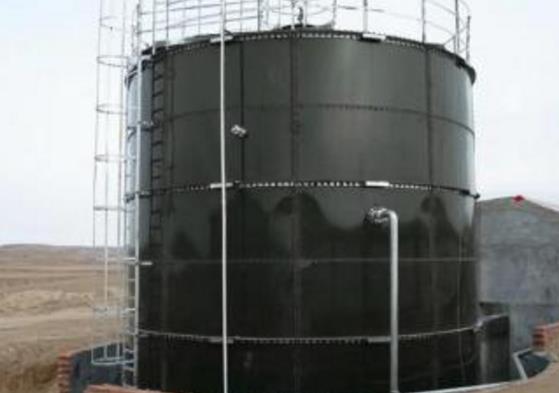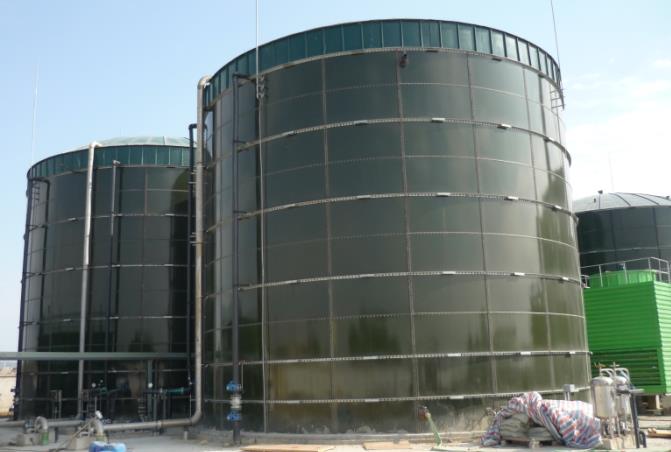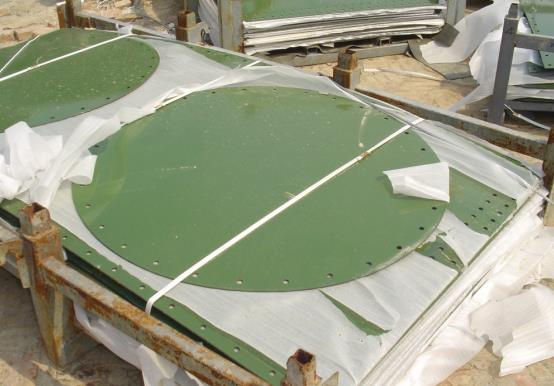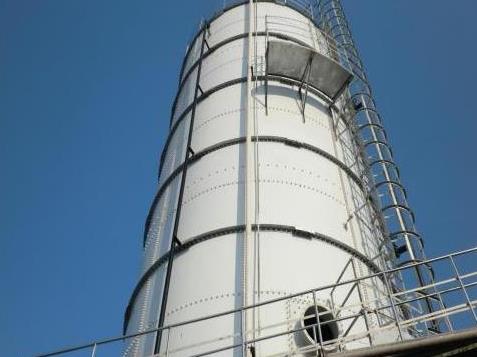Glass fused tanks
2018-10-31 08:00:42 By:NVirotech Bolted Tank (2413)
Glass fused tanks for sale
Glass fused tanks refers to the thermal equipment used to make glass batch in glass manufacturing. The powder and the clinker (broken glass) mixed according to the glass composition are melted and clarified at high temperature in the kiln, and the glass liquid which meets the molding requirements is formed.
Glass has a history of 5,000 years, and the manufacture of fused glass batches in mud tanks fueled with wood has lasted for a long time. In 1867, SIEMENS brothers in Germany built a continuous coal fired kiln. After 1945, Glass fused tanks developed rapidly.

Heat transfer includes flame space heat exchange caused by temperature difference in flame space and glass liquid, heat exchange in glass liquid, heat exchange in regenerative chamber and heat exchange between kiln wall and external environment.
Momentum transfer: incompressible gas flow, compressible gas flow, gas jet flow and glass liquid flow caused by pressure difference.
Mass transfer: gas diffusion caused by gas phase concentration difference and liquid phase diffusion caused by glass liquid concentration difference in combustion process.
Glass fused tanks. They include 4 parts: glass melting, heat supply, waste heat recovery and smoke exhaust and gas supply.
One or more crucibles are placed inside the kiln. The melting stages (melting, clarifying, homogenizing and cooling) of glass in crucible kiln proceed in turn with time in the same crucible, and the temperature system in the kiln changes with time. When forming, the crucible is manually taken from the mouth of the crucible, then blown, pressed, pulled, poured and so on.
The crucible can also be supplied with the bottom of the crucible, or the whole crucible can be removed from the crucible. Crucible materials are mostly clay and platinum. There are two kinds of shapes: opening and transverse (closed). The open crucible orifice faces toward the kiln, which can directly obtain the heat radiation and transfer from the kiln wall and heat source. The cross crucible orifice faces out of the kiln and obtains heat indirectly through the crucible wall, which can avoid the influence and pollution of the atmosphere in the kiln on the glass liquid. Crucible kiln is suitable for melting glass with small output, variety or changing material.
The kiln chamber contains a refractory material masonry pool, and the mixture is melted into the furnace pool. There are two types of tank kiln, intermittent and continuous. Intermittent pool kiln, also known as "day pool" kiln, is generally small, and the pool area is only a few square meters. After the melting process is completed, most of the materials taken from the reclaiming mouth are either manual or semi mechanical. It is suitable for producing special glass.
Most of the kilns belong to continuous type (Fig. 2 The structure of continuous type kiln is illustrated), and each melting stage is carried out in different parts of the kiln. The temperature regime of all parts is stable.
The batch is fed into the melting part by the feeding port, which undergoes the process of melting, clarifying and homogenizing the liquid glass, then transfers to the cooling part for further homogenizing and cooling, and then enters the forming part for final homogenizing (including the homogenizing of the liquid glass temperature) and stabilizing the feeding temperature. Due to the low temperature of liquid glass near the bottom of the kiln and the stagnation state, the total volume of liquid glass in the kiln is larger than that of the working glass, and the amount of feeding and molding kept a balance in the continuous operation. The molten glass melts are mechanized continuously.
The scale of the furnace is represented by the area of the melting part (m *). The melting area of the large tank glass furnace is more than 150 m_, and the production capacity can usually reach 300-400 t/24 h, and the melting rate can reach 2.5-3 t/24 h_m_. Continuous tank kiln has large capacity, less heat loss and higher thermal efficiency than crucible kiln. It is suitable for large-scale and high-efficiency continuous production.
Glass fused tanks in china
Because of the different heat sources used in Glass fused tanks, the structural form is quite different. Such as flame melting furnace, electric melting furnace and flame electric melting furnace have different structures.
A furnace that uses coal, heavy oil, gas or natural gas as fuel. Coal-fired crucible kiln is equipped with a fire box. After coal burning, half gas is produced, which is mixed with secondary air to burn in the flame injector, and the flame transmits heat in the space of the kiln. An oil nozzle is set up in the crucible kiln of the fuel oil, and the oil mist is emitted in the flamethrower tube.
The gas-fired tank kiln is equipped with a small furnace, which is composed of an air passage, a gas passage, a tongue, a preheating chamber and an outlet. The fuel tank has a small furnace, consisting of an oil nozzle, an air passage and a spray outlet. Horseshoe flame kiln is called horizontal flame kiln whose flame flow direction is perpendicular to kiln shaft and longitudinal flame kiln whose flame flow direction is consistent with kiln shaft, which is called horseshoe flame kiln with horseshoe rotation.
In order to cool the glass liquid in the cooling section, a partition device such as a lattice wall, a low belly or a hanging wall is arranged between the melting section and the cooling section, and a flow hole, a floating block and a clamp neck are arranged at the bottom to regulate the fluid flow and block the unmelted sand scum, and a cooling pipe is used to cool the glass liquid. Cooling section is often connected to one or more forming parts to distribute glass liquor, and is divided into bottle glass kiln, flat glass kiln, pipe pulling kiln, optical glass kiln, ball kiln and other forms because of different product varieties and molding methods.
The flame in the flame furnace leaves the furnace with a large amount of waste heat, which can be used to heat combustion-supporting air and gas to improve the flame temperature and save fuel. The waste heat is mainly regenerative chamber or heat exchanger. Fig. 2 the continuous pool structure indicates that the continuous kiln with residual heat is recovered by the regenerator.
The regenerator uses grid bricks to store part of the heat discharged from the kiln chamber. After a certain period of time, the heating operation is reversed, and the lattice brick transfers the accumulated heat to the combustion-supporting air and gas entering the regenerator. To this end, the regenerator must be set in pairs to make indirect heating work continuous. The heat exchanger uses ceramic components or metal pipes as heat exchangers to transfer flue gas heat to combustion-supporting air continuously through the channel wall. Crucible kiln adopts heat exchange type, simple structure and stable operation. Pool kilns (especially large-scale pond kilns) are usually of regenerative type with high efficiency and reliability of waste heat recovery, but reversing equipment is required.
A furnace that uses electric energy as a source of heat. The crucible kiln has two kinds of heating methods: resistance heating and induction heating. In general, silicon carbide or molybdenum disilicide resistance heater is installed on the side wall of a crucible kiln for melting optical glass to conduct indirect resistance radiation heating. Some crucible kilns for melting special glass adopt induction heating method, which is heated by eddy current produced by induction in the kiln and glass liquid.
The tank kiln directly uses the glass liquid in the kiln as the heating resistance. Multiple groups and multi-layer electrodes can be arranged at different depths of the glass liquid to heat the glass liquid. The temperature system can be controlled by adjusting the power consumption.
In this way, the space temperature above the glass liquid level is very low (called cold furnace top), so the energy is basically consumed in the melting glass and kiln wall heat dissipation, no loss of heat and flue gas emissions of environmental pollution, high thermal efficiency, and does not need to set up a combustion system and waste heat recovery system. The battery kiln can be controlled automatically, with few management personnel and good working conditions, but the power consumption is large. It is suitable for melting refractory glass, volatile glass and dark glass. The capacity of large battery kiln to produce bottles and cans is 150t per day.
A mixed tank kiln mainly based on flame heat source and heat resistance of glass liquid. The operation is similar to the flame pool kiln. In order to increase the melting rate to increase the production capacity and improve the quality of melting, clarifying and homogenizing of liquid glass, electrodes were embedded in the hot spot and feeding port of the flame tank kiln for auxiliary heating, and good results were obtained.
-
Related News:
- how to fix bolted glass lined steel tanks
- bolted steel tanks australia
- wastewater bolted storage tanks for sale
- supplier for steel bolted water tank in philippines
- Hello,2020
- enamel steel plate





